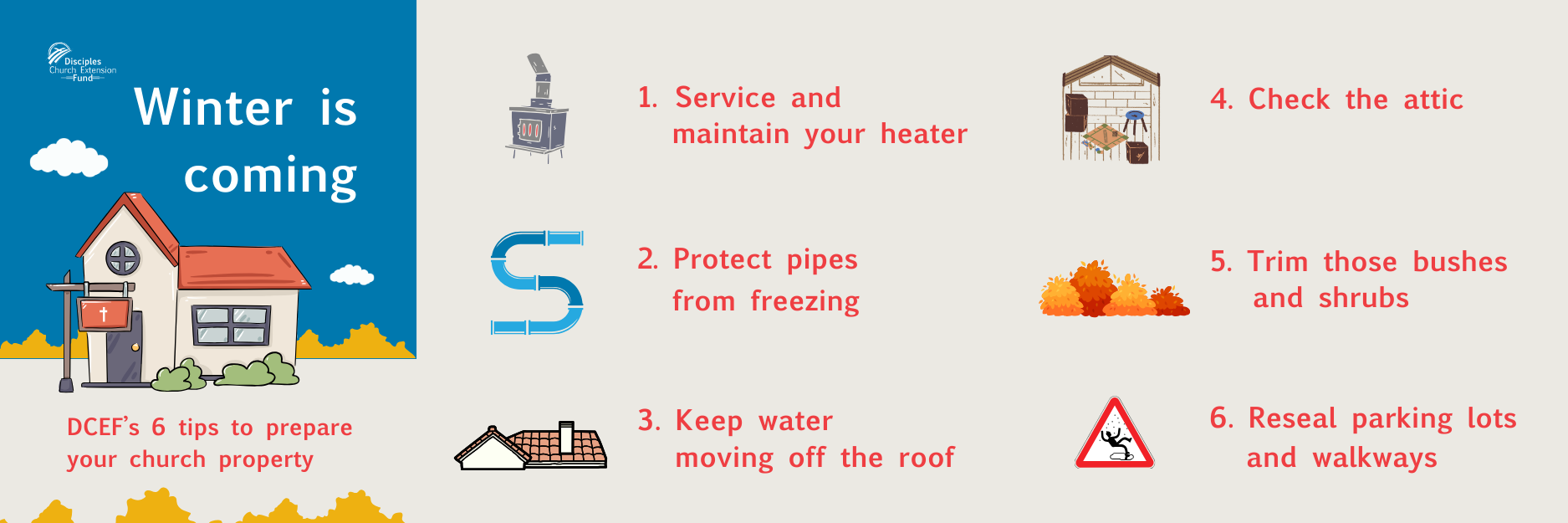As winter approaches, thoughts turn to decorating for the holidays. But it’s a good idea to add winterizing to the list of late Fall activities, according to Disciples Church Extension Fund Building and Capital Services Advisor Jim Michel.
“Maintaining your church so it’s ready to withstand harsh weather can ensure your congregation can enjoy the cold weather season without any unhappy surprises along the way,” he said.
Here are six tips to prepare for winter:
1. Service and maintain your heater.
- Have a licensed, experienced heating contractor inspect and service your system for proper operation.
- Check furnace filters monthly. Replace them quarterly or according to the manufacturer’s recommendation.
- Keep combustible material at least 36 inches (91 centimetres) from heating units. Never store items like gasoline or paint thinner in the same room as these units.
2. Protect pipes from freezing in cold temperatures.
- Close windows near water pipes and cover open-air vents to protect exposed pipes. Wrap water pipes in unheated or non-insulated areas with pipe insulation.
- Disconnect hoses on outside faucets before the winter freeze arrives.
- Winterize lawn irrigation systems using pressurized air to blow the water from the pipes. We recommend getting professional help for this task.
- When temperatures drop precipitously, turn interior faucets to a slow drip to reduce the chance of the pipe freezing. Be sure the drains work correctly if the dripping tap is left unattended.
- Install wireless temperature sensors in attic spaces that have water or pipe heaters. The sensor can be set up with alerts for specific temperatures.
- All church administrators should know the location of the main water shut-off valve in your building. Quick access to the valve means a faster response that can limit water damage in case of a leak or burst pipe.
- If all else fails and a pipe freezes or bursts, turn off the water, then contact a licensed plumbing contractor immediately.
3. Keep water (and ice) moving off the roof.
- Examine the roof for cracking, blistering, cupping, peeling, or loss of granulation in asphalt shingles. Identifying and repairing roof damage can prevent even more significant losses from leaks.
- Inspect drains, gutters, and valleys to ensure no leaves, twigs, and other debris have built up to block water from draining off the roof.
- Check downspouts for debris and ensure roof runoff is led away from the building’s foundation.
- Clear snow about two or three feet from all roof edges to prevent ice dams. Consider hiring a qualified and insured contractor to carry out this work. Snow and ice can damage existing roofing components. Removal can be dangerous and add to the damage if not done correctly.
4. Check the attic.
- Ensure the attic has sufficient insulation and ventilation. Rust or the smell of mildew could point to inadequate ventilation. Install soffit vents to provide more ventilation.
- Seal any openings in the attic, like heat ducts, light fixtures, and vent pipes.
5. Fall is the time to trim those bushes and shrubs.
- Prune plantings close to your building; snow and ice add weight to their branches, which can fall and damage the structure. Ensure branches don’t hit the building’s walls or roof.
- Remove anything under the branches that might appeal to rodents.
6. Parking Lots and Walkways
- Fill cracks and reseal surfaces every three to five years.
- Use ice melt according to the manufacturer’s instructions with care about how much to spread. Over or under-application can result in damage to surfaces.
 Download the full image.
Download the full image.
Read more here to learn how to help congregations impacted by climate crises.

